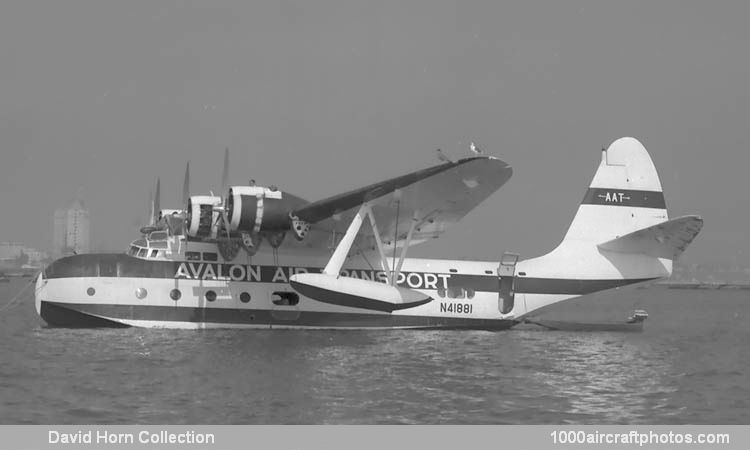10/31/2009. Remarks by Johan Visschedijk: "In 1935 the Bureau of Aeronautics of the USN issued a requirement for a large long-range armed patrol aircraft. In June 1936 the Model S-44 proposal issued by Sikorsky was awarded a contract for the production of a single XPBS-1 under BuNo. 9995. With a crew of six and powered by four 1,050 hp Pratt & Whitney XR-1830-68 Twin Wasp fourteen-cylinder two-row air-cooled radials, the prototype first flew on August 13, 1937.
Armament comprised a single 0.5 in (12.7 mm) machine gun in the nose and tail positions and one 0.303 (7.62 mm) gun in each of the two waist positions, and an internal weapon load of 4,000 lb (1,814 kg) could be carried over a range of 3,170 mls (5,102 km). Delivered to the USN in October 1937, it was used for special operations, until it capsized in San Francisco Bay in early 1942. No further PBS-1s were produced.
Further development of the basic type resulted from the ambitions of a major US shipping company, American Export Lines, to break into the increasingly lucrative long-haul airline business, to which end it had formed American Export Airlines (AEA) in April 1937. In May 1939 this company applied for a license to operate a flying boat service from New York to the United Kingdom and France, the chosen aircraft was a civil development of the XPBS-1.
In 1939 Sikorsky had merged into Vought-Sikorsky, so the development, designed by Michael Gluhareff, was designated VS-44A, AEA ordered three examples. The outbreak of WW II led to a postponement of AEA's plans, but in July 1940 the airline secured presidential permission to operate a transatlantic service from New York to Lisbon. AEA confirmed its order with accommodation for up to 16 passengers over transatlantic routes. (Later the seat capacity was increased to 47.)
The situation was once again changed when the United States entered WW II as a result of Japan's attack on Pearl Harbor in December 1941. On January 12, 1942,the USN thus contracted with AEA to operate its VS-44As on behalf of the Naval Air Transport Service on the North Atlantic route, operating from New York to Foynes in Ireland.
The aircraft were designated XJR2S-1 by the USN and received the BuNos. 12390 to 12392, c/n 4401 to 4403, although they were finished in civil markings and registered NC41880 (initially NX41880) to NC41882; AEA named them Excalibur, Excambrian and Exeter respectively. Powered by four 1,200 hp R-1830-S1C3-G Twin Wasps, the first was flown on January 18, 1942, the first transatlantic flight was made on June 20, 1942, while all three aircraft had been delivered by June 1942.
NC41880/12390 crashed on take off at Botwood, Dominion of Newfoundland, on October 3, 1942, 5 out of 11 crew and 6 out 26 passengers were killed. The other two made 405 transatlantic crossings before being retired by AEA in October 1945. In1946 NC41882/12392 was sold to TACI Ltda. (Transporte Aéreo de Carga Internacional) of Montevideo, Uruguay, registered as CX-AIR. It was damaged beyond repair while landing on the Río de la Plata, off Montevideo, on August 15, 1947, 4 out of 5 crew killed but both passengers survived.
NC41881/12391 was rebuilt to carry freight in 1950, stranding at Ancón Harbor, near Lima, Peru. In 1957 it was acquired by Avalon Air Transport of Avalon, California, and flown back to the USA, reregistered N41881. The airline was renamed Catalina Airlines in 1963, and operations were ended in 1968. Sold to Antilles Airboats in the Virgin Islands, the VS-44A was damaged beyond economical repair by rocks on January 3, 1969, while taxiing in Long Bay, Charlotte Aunalie, Virgin Islands, and it was beached in 1972.
In 1976 Antilles Airboats donated the aircraft to the Naval Aviation Museum in Pensacola, Florida, USA, where it was stored till it was moved to Bridgeport, Connecticut, for restoration by volunteers, including (retired) Sikorsky personnel. After a lengthy restoration (1987-1998) the aircraft was put on display (on permanent loan) the at New England Air Museum, Windsor Locks, Connecticut."
